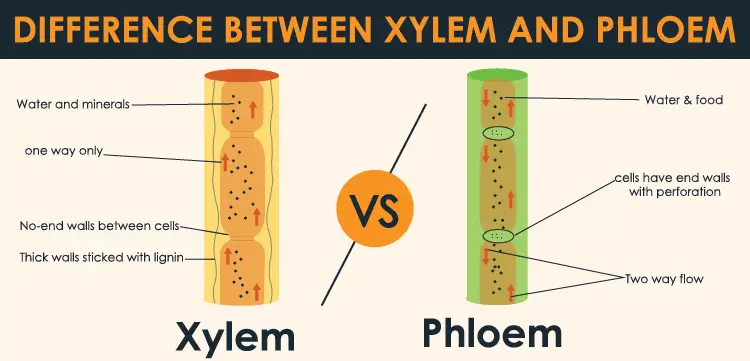
Difference between Xylem and Phloem
The very basic difference between Xylem and Phloem is that xylem conducts water and nutrients from the soil to stem and leaves while phloem transports food from leaves to all parts of the plant.
Plants are categorized on the basis of many criteria.and one such category is due to the presence or absence of a vascular system. There are specialized features in vascular plants that help them to absorb water and minerals from the soil. These include specialized tissues such as xylem and phloem.
Xylem and Phloem are two types of vascular tissues which are different from each other. These vascular tissues perform their activities side-by-side. Another difference between xylem and phloem is that the movement in the xylem is unidirectional while in phloem it is bidirectional.
Difference between Xylem and Phloem

Difference between Xylem and Phloem in tabular form:
| · Xylem | · Phloem |
| 1. Located at the Centre of vascular bundle | Located at the outer region of the vascular bundle |
| 2. Possess smaller fibers | Possess larger fibers than xylem |
| 3. Xylem tissues exist in tubular shaped structure with the absence of cross walls. | Phloem tissues exist in elongated, tubular-shaped structures, that also include thin sieve tubes with walls |
| 4. Present in leaves, stems, and roots of the plant. | Present in leaves, stems and, roots but transports and grows in fruits, seeds, and roots. |
| 5. Possess unidirectional content movement | Possess bidirectional (two-way) content movements. |
| 6. Live with hollow dead cells. | Live with cytoplasm without the nucleus. |
| 7. The net amount of xylem tissues in a plant is more than phloem. | Less net amount than xylem |
| 8. Consists of vessel elements, tracheid, xylem sclerenchyma, xylem parenchyma, and ultimately xylem tissues | Consists of companion cells, sieve tubes, bast fibers, intermediary cells, phloem parenchyma and ultimately phloem tissues. |
| 9. Transport soluble minerals and nutrients from roots up to the aerial parts of the plant | Transport nutrients including sugars and amino acids from leaves to storage organs of the plant. |
| 10. Forms vascular bundles with phloem | Forms vascular bundles with xylem |
| 11. Provides mechanical support to the plant | It does not provide mechanical support but only transfers the nutrients made as a result of photosynthesis. |
| 12. Responsible for acquiring the total amount of water that is lost as a result of photosynthesis and transpiration. | Responsible for transporting the proteins and mRNA across the plant. |
Xylem Tissues:
Xylem is the most important tissue of the vascular system of plants. It performs the main activity which is acquiring water and minerals from the soil and transporting them to all parts of the plants. It possesses two separate chambers called tracheids and vessels which are actually used for transporting minerals and water.
Phloem Tissues:
Phloem is as important as the xylem tissues for the vascular system of plants. It performs the main activity of transporting the food and nutrients from leaves to all parts of the plant. Remember, these food and nutrients are the product of photosynthesis
also read:
- Difference between photosynthesis and respiration.
- Difference between pollination and fertilization.